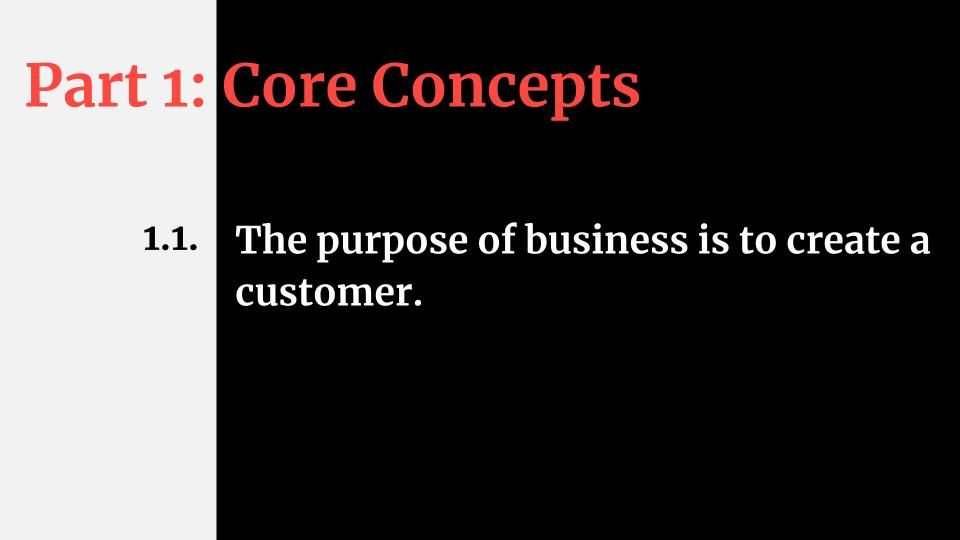1.1. The purpose of business is to create a customer.

".... Marketing is too important to be left to the marketing people."- David Packard, founder of Hewlett-Packard
The purpose of the business is the core around which all organizations, for-profit and nonprofit, are built. Having the wrong core leads to wrong strategies based on incorrect principles.
It is easy to assume that the goal of every business is to generate revenue and profit. Both are required for the long term survival of a company. Aside from pure survival, profitability provides the necessary resources for growth and innovation. Profit is also a powerful motivator. But what we often forget is that profit can be generated only when there are people or companies that are willing to pay for products or services that are produced and delivered.
Take any organization and ask this question: Why does it exist? Let's start with the first answer that comes to mind — a company exists to make money. Sure, but how does the organization generate revenue and profit? It makes money by selling something valuable. Excellent, but how do you know what’s valuable? Finding valuable products or services through trial and error is part of the answer. However, understanding who will buy your product and what they actually want is the key to delivering something valuable to the marketplace.
There is no demand in the market for any product or service until it is created. A customer may feel a certain problem, need, or want but until a product or service is provided there is no demand. So, it is business people that convert customers’ wants and needs into market demand. Essentially, customers and markets don't exist before they are created. (source: The essential Peter Drucker).
Therefore, profit is not the purpose of the business, it's a byproduct. The purpose of business is to create a customer. Peter Drucker, a legendary management consultant, formulated this idea best. The existence of the customer is the cornerstone of every enterprise. The profitability is impossible without the existence of a customer. Hence, creating a customer is a primary purpose of business.
It’s easier to understand how creating customers applies to startups (young companies) but what about old and established industries. How does a local utility company create customers? These companies operate in the markets that have been around for a while and many stopped innovating a long time ago. But utility companies wouldn't exist today if they didn't create a customer and market for their products in the early stages of their development. Furthermore, if a company stops innovating its products or creating demand for new customer segments it runs a risk of being replaced by an organization that creates new customers.
It’s easy to dismiss or devalue the idea that customer creation is a reason for corporate existence as both too philosophical and impractical. However, you can't understand business and marketing without fully grasping that an organization can only survive when a group of people (customers) values something it produces. This idea can be applied beyond the business arena. No non-profit or political organization can survive without a critical mass of people that consume tangible or intangible products and services that it produces.
Every organization comes together as a group to provide value to another group of people united around a specific interest, need, value, or characteristic. In other words, creating a customer is the goal and purpose of every organization.
Creating a customer is not a strategy or tactic, and it's difficult to see how this idea is helpful for a professional in day-to-day work. Nevertheless, it sets the mindset that's crucial for business people and marketers in particular.
First, it shifts the focus from profit and revenue generation to a customer. The profit takes care of itself after you take care of your customer, to paraphrase a famous quote from legendary football coach Bill Walsh (source - The Score Takes Care of Itself). Just thinking about how to make money won't get you closer to understanding customer needs or creating a product that satisfies these needs. Profitability, of course, is required for long term success (unless we’re talking about Uber or WeWork). But it can only be achieved through a customer creation process that leads to higher market demand. In other words, companies need to make something people want. Paul Graham, the founder of YCombinator, established it as a motto of the widely successful startup accelerator he founded. (counter argument Marketing a Love story pg 63)
Second, if market demand doesn't exist until it’s created it leads to the conclusion that it’s almost impossible to estimate the demand for a new product or service. A customer for a new product might be unaware of his or her needs. The customer pain may have been unfelt until the solution becomes accessible (source The Essential Peter Drucker). No one was demanding cars before they were available and marketed. Despite the large benefits of owning an automobile it took a decade or so to generate wide customer demand. Creating demands requires customer education of product values and benefits. The estimation of market demand for a new product is never accurate enough to be useful.
Third, while understanding your potential customer's needs, wants, and pains is important, don't expect your potential customers to explicitly tell you what to build or how. Customers don't know the solution to their own problems. The goal for the company is to bridge the gap between what potential customers experience with products or services that improve this experience in an emotional or financial way.
In summary, the purpose of business is to create a customer and not to generate revenue. Companies must focus on customers to generate market demand. Customer demand is generated through new product introductions, marketing, and education. Don't expect your customers to tell you what to build and how. It’s the company's job to bridge the gap between the customers’ needs and product value.
Checkout my course on How to Conduct Customer Interviews
